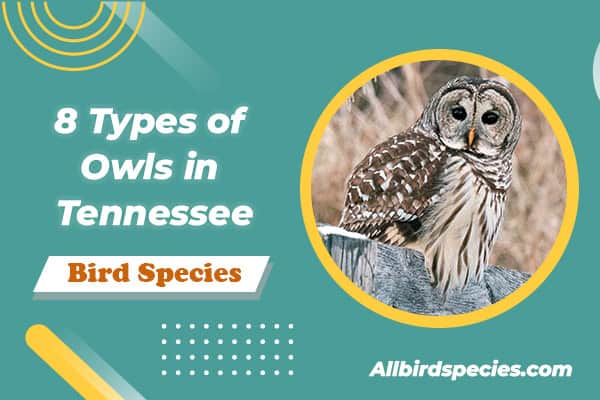8 Owls in Tennessee (ID Guide With Photos)
As an owl aficionado in Tennessee, I’ve researched the night’s winged wonders. Owls in Tennessee are a sight to behold, from the regal Great Horned to the charming Eastern Screech-Owl. This guide is your ticket to their world.
I’ll unveil each owl’s secrets, from haunting calls to stealthy flights. You’ll discover where they lurk and how they live. It’s not just facts; it’s a peek into their mysterious lives.
You don’t need to be an expert to appreciate their majesty. This ID guide is crafted for both the curious and the devoted. So, let’s set off on this wild, feathered quest. Binoculars in hand, we’re about to explore Tennessee’s most elusive residents.
Here, We’ll Learn About 8 Types Of Owls Found in Tennessee!
1. Great Horned Owl
The Great Horned Owl, also known as Bubo virginianus, is one of the most majestic and formidable owls you can find in Tennessee. With its distinguishable features and powerful presence, this species has captivated the imagination of bird enthusiasts and nature lovers alike.

Characteristics
The Great Horned Owl is a large owl species, ranging in size from 18 to 25 inches tall, with a wingspan of 3.3 to 4.8 feet. These owls have distinctive ear tufts on their heads, which are not actual horns but feathers that help with camouflage and communication.
Their plumage varies, ranging from mottled shades of brown and gray to reddish-brown. This varied coloration helps them blend into their natural habitats, making them excellent hunters.
Habitat and Behavior
The Great Horned Owl is a really cool bird that can live in lots of different places. Firstly, it’s happy in forests, near deserts, swamps, and it can even hang out in cities. Moreover, if you’re in Tennessee, you can find these owls everywhere, from the big mountains in the east to the flat lands in the middle.
Secondly, these owls are night-time hunters, which means they’re super good at finding food when it’s dark. They have amazing eyes that can see really well at night, and their hearing is top-notch. This helps them catch all sorts of animals like mice, rabbits, other birds, and sometimes even snakes and lizards
Spotting the Great Horned Owl in Tennessee
If you want to catch a glimpse of the Great Horned Owl in Tennessee, head to forests, woodlands, or open fields during dusk or dawn. Listen for their distinctive hooting calls, which can carry over long distances.
Keep in mind that Great Horned Owls are nesting birds, so during the breeding season, they may become more territorial. If you spot a nest, observe from a distance and respect their space.
| Owl Species | Length | Wingspan | Weight |
|---|---|---|---|
| Great Horned Owl | 18-25 inches | 3.3-4.8 feet | 2-5 pounds |
| American Barn Owl | 14-20 inches | 3.3-3.8 feet | 14-24 ounces |
| Barred Owl | 16-24 inches | 3.3-3.8 feet | 16-37 ounces |
| Eastern Screech-Owl | 7-10 inches | 18-24 inches | 6-9 ounces |
| Long-Eared Owl | 13-16 inches | 33-39 inches | 7-12 ounces |
2. American Barn Owl
The American Barn Owl is a captivating species of owl that can be found in Tennessee. Known for its distinct heart-shaped face, this owl is easily recognizable and a favorite among birdwatchers and nature enthusiasts.

One of the unique features of the American Barn Owl is its ability to adapt to various habitats. While it is commonly associated with barns and other man-made structures, it can also be found in open grasslands, farmlands, and even urban areas. The owl’s adaptable nature makes it a versatile species that can thrive in different environments.
Habitats and Hunting Techniques
The American Barn Owl prefers to roost and nest in secluded areas such as abandoned buildings, tree cavities, or dense vegetation. It hunts primarily at night, using its exceptional hearing and silent flight to locate prey in the darkness.
When hunting, the American Barn Owl relies on its sharp vision and acute hearing to detect small mammals, birds, and insects. Once prey is spotted, the owl swoops down silently and grabs its target with its sharp talons. Its ability to fly silently makes it a stealthy predator, ensuring a successful surprise attack.
The American Barn Owl’s unique hunting techniques and remarkable adaptability make it a fascinating species to observe in the wild.
It is essential to be able to differentiate the American Barn Owl from other owls species commonly found in Tennessee. While its heart-shaped face is a standout feature, other characteristics can aid in identification. The American Barn Owl has relatively long legs, a pale-colored plumage with speckles, and a medium-sized body compared to other owls.
Although the American Barn Owl is primarily active at dusk and dawn, it can also be seen during the day if its roost is disturbed. With its graceful appearance and silent flight, spotting this owl is a remarkable experience that leaves a lasting impression.
| Owl Species | Distinct Features |
|---|---|
| American Barn Owl | Heart-shaped face, long legs, pale-colored plumage with speckles, medium-sized body |
| Great Horned Owl | Prominent ear tufts, large size, hunched posture |
| Barred Owl | Distinctive “Who cooks for you?” call, dark eyes against lighter facial feathers, vertical barring on chest |
| Eastern Screech-Owl | Small size, ear tufts, mottled feathers, wide variety of colors |
Observing the American Barn Owl in its natural habitat is a thrilling experience that allows you to appreciate the beauty and adaptability of these magnificent creatures. Remember to respect their space when birdwatching and maintain a safe distance to ensure their well-being.
3. Barred Owl
The Barred Owls exhibit little migratory behavior, and their territories are remarkably small compared to other owl species.
Despite their extremely sedentary tendencies, the Barred Owl is widely distributed throughout the eastern United States and southern Canada. Also, These owls display a predominantly brownish-grey hue, with distinctive dark striping on their underside. Besides this, A Barred Owl waiting patiently for its prey on a branch Similar to the American Barn Owl, on the other hand Barred Owls are devoted to their partners and exhibit monogamous behavior.

During the mating season that starts in February, the male owl nods and bows with outspread wings to woo his potential mate. The Barred Owls build their nests in deep, dark forests using hollow tree trunks as their preferred nesting location. Barred Owls hunt in the forests with great precision.Their diet mainly comprises small mammals, but they are also known to catch fish and small birds. They prefer hunting around forest rivers and wetlands.
The Barred Owl is widely distributed in all of North America, and their population is estimated to be approximately 3 million individuals globally. Nevertheless, the poisoning of their prey is a significant threat to the Barred Owl, as with other owl species. They are also threatened by habitat destruction and disruption and are thus highly detrimental to the Barred Owl, as they thrive in deep, dark forests
Fun Fact:
The Barred Owl is known to have a diverse repertoire of vocalizations, including hoots, screams, and gurgling calls. Its haunting hoots, often described as “Who cooks for you?”, are a signature sound of the forest.
4. Eastern Screech-Owl
The Eastern Screech-Owl, scientifically known as Megascops asio, is a master of camouflage. Its feathers come in various colors, including gray, red, or brown, allowing it to blend seamlessly with its surroundings. This owl’s small body and distinctive tufts on its head give it a charming appearance.

These owls are typically found in wooded areas, where they nest in tree cavities or take over abandoned nests of other bird species. While the Eastern Screech-Owl primarily hunts small mammals, it also enjoys feasting on insects, birds, and reptiles.
One fascinating aspect of the Eastern Screech-Owl is its vocalizations. Unlike its name suggests, this owl doesn’t screech but produces haunting trills and whinnies. These calls serve to mark territory, communicate with other owls, and attract mates.
5. Long-Eared Owl
The Long-Eared Owl, scientifically known as Asio otus, is named after its distinctive long ear tufts or “horns.” These tufts are not ears but feathers that help with camouflage and communication. With its mottled brown and beige plumage, the Long-Eared Owl is a master of disguise.

This owl prefers dense forests and woodlands for nesting and roosting. It constructs its nests in the nests of other birds or abandoned squirrel dreys. The Long-Eared Owl primarily hunts small mammals like mice and voles but also consumes birds and insects.
While the Long-Eared Owl is generally a silent species, it can produce a variety of calls, including soft hoots and low chuckles. These vocalizations are used for territorial defense, courtship, and communicating between family members.
Best Places to Find Them
If you’re eager to spot the Eastern Screech-Owl and Long-Eared Owls in Tennessee, here are some excellent locations to explore:
| Location | Eastern Screech-Owl | Long-Eared Owl |
|---|---|---|
| Great Smoky Mountains National Park | ✔️ | ✔️ |
| Reelfoot Lake State Park | ✔️ | ✔️ |
| Hiwassee Wildlife Refuge | ✔️ | ✔️ |
| Chickasaw State Park | ✔️ | ✔️ |
These locations offer suitable habitats for these owl species, giving you a higher chance of encountering them in their natural environment. Remember, owls are mostly active during the night, so plan your visits accordingly and listen for their distinctive calls.
Learn more about the Netvue Birdfy Hummingbird Feeder Camera HERE!
6. Short-Eared Owl
The Short-Eared Owl, known for its distinctive facial disc, is a migratory species that visits Tennessee during the winter months. They can be found in open grasslands, marshes, and fields where they hunt small mammals. Spotting them during dusk or dawn can be truly magical.

Distribution and Prevalence:
- The Short-Eared Owl is widely distributed across the globe and is known to be one of the most prevalent owl species.
- Its short, black bill complements its dotted brown body, which features a barred tail and wings
Daytime Activity:
- Unlike its nocturnal counterparts, the Short-Eared Owl is predominantly active during daylight hours.
- It uses this time to hunt for its prey.
Appearance:
- The feathers on its breast are a shade of brown, while its belly is light in color.
- Its short and black bill is a notable feature.
Breeding Behavior:
- The Short-Eared Owl engages in serial monogamy.
- Pairs remain together for a single breeding season, which typically commences around March.
Nesting Habits:
- Unlike other owls, this bird congregates in flocks.
- They construct their nests on the ground in sparsely vegetated areas such as prairies, meadows, or tundras.
Hunting Techniques:
- The Short-Eared Owl hunts both during the day and at night.
- It flies low over open fields in search of prey.
Diet:
- While voles are their preferred meal, like many other owls, they also eat other small mammals and even birds and amphibians when vole populations are scarce.
Population Challenges:
- Despite being one of the most common owls in the world, the Short-Eared Owl’s population is declining due to habitat loss and roadside fatalities.
7. Northern Saw-Whet Owl
The Northern Saw-Whet Owl, on the other hand, is a year-round resident of Tennessee’s forests. With its small size and adorable appearance, it captures the hearts of many bird enthusiasts.

Look for them perched in dense vegetation and listen for their distinctive tooting call.
8. Snowy Owl
The Snowy Owl is a really special kind of owl that lives in the Arctic but comes to North America for the winter. It’s famous for being all white, like a beautiful snowball!
The male are mostly white, but the female have some dark feathers mixed in with the white ones, which makes them look really elegant. Unlike most other owls of tennessee, Snowy Owls are active both during the day and at night. This might be because they live in a place where the days are really long in the summer and really short in the winter.

These owls travel a lot, moving from where they breed in the Arctic to where they spend the winter, and they go really far each time. When they get to the Arctic in April, the boys find a good spot and show off by singing and flying around to impress the female. They even offer food to the female they like!
When it’s time for babies, the female don’t make a real nest but just scrape a little hole in the ground for the eggs. In the winter, their diet changes. They mostly hunt at night and eat small animals like rats and birds that live near water. But in the summer, when they’re in the Arctic, they mostly eat lemmings, because that’s what’s available.
Because Snowy Owls of tennessee move around so much, it’s hard to know exactly how many there are. But experts think their numbers are going down, mainly because of climate change.







